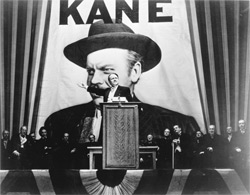Click here to read Elbert Ventura's essay on the new DVD of Orson Welles' The Magnificent Ambersons.
 In September 2008, I wrote a Slate column urging all film-lovers to go buy a Blu-ray player so they could watch the new digital restorations of The Godfather and The Godfather Part II in a format that looked?in clarity, color, and detail?remarkably close to the original 35 mm prints.
In September 2008, I wrote a Slate column urging all film-lovers to go buy a Blu-ray player so they could watch the new digital restorations of The Godfather and The Godfather Part II in a format that looked?in clarity, color, and detail?remarkably close to the original 35 mm prints.
If you didn't take my suggestion then, it's time to reconsider. This week, the American film classic, Citizen Kane, comes out on Blu-ray, and the difference between this disc and any other version you've seen?on TCM, at a repertory movie theater, or on the DVD released nine years ago?is stunning.
That 2002 DVD was a revelation at the time, so much brighter and clearer than the murky 16 mm prints that most of us had seen on TV or at college film societies. But as DVD technology improved, as digital artisans refined their skills, and as the studios released discs of other classic films that bore the fruits of this progress (e.g., the gorgeous DVDs of Casablanca, The Treasure of the Sierra Madre, The Maltese Falcon, and even old silents by Buster Keaton and Charlie Chaplin), the digital Citizen Kane didn't hold up. It was too bright, too clean; the dirt and grime had been cleared away, but so had a good deal of the texture, the depth, and the sense of film grain. (John Lowry, the brilliant pioneer in digital restoration who worked on that version of Kane, admitted to me a couple years later that he'd gone too far; the field was still very young, he said, and it took him a while to learn all its lessons.)
The new Blu-ray is just as spotless (more so, actually), but it also retains the texture, the grain, and all the rest. In those startling shots where director Orson Welles and his cinematographer, Greg Toland, light the set so everything from close-up foreground to distant background is in focus, we finally do see everything clearly. In that last shot of all of Kane's discarded junk in the warehouse, we see what all the junk is. Facial expressions, bric-a-brac on shelves, the full jolt of the jump-cuts from a dark scene to a bright scene and all the shades-of-gray scenes in between?everything is clear and looking very much like film.
The Blu-ray also brings out the mood of the film?or, rather, its subtly contrasting moods?with an intensity that I'd never noticed in all the times I've watched this movie.
Citizen Kane, of course, is the story of Charles Foster Kane (played by Welles at the amazingly young age of 25), a newspaper tycoon and aspiring politician-savior loosely based on William Randolph Hearst. But the story is told in flashbacks, after Kane has died, from the vantage point of multiple narrators?various people in Kane's life, who have very different feelings toward him. This device had always struck me as a bit of a gimmick, but the Blu-ray reveals the slight differences in lighting that impart a visual mood to the different narratives: some starker, some warmer, some more intimate, some more hollow. These contrasts were muffled, flattened out, in earlier versions. This is a more richly emotional Kane.
The stories also flow more smoothly. To an amazing degree for a film made in 1941, Citizen Kane is loaded with special effects, most of them the product of optical printing?multiple exposures, live footage superimposed on top of still photos on top of animated drawings, as well as swift dissolves from one scene to another. In the early days of film, these "opticals" often produced jarring side-effects: jitter, flickering, or images in the different layers moving at uneven speeds. Over time, dirt, dust, and grime tended to worsen these problems, especially before film preservation took off as a cause.
Thanks to new digital technology (much of which wasn't available even a decade ago), these anomalies have been cleaned up and smoothed out. The fabrications look less fake, or there's less jumpiness drawing our attention to the fakery; in any case, there are far fewer times when Welles' technical tricks take us out of Welles' (and co-scenarist Herman Mankiewicz's) story.
But the main improvement (without which most of the other improvements would not have been possible) is that, for this new edition, the film was digitally scanned at a much higher resolution.
A little background: Digital video is mastered by putting a film through a machine that digitally scans each frame, storing the information as a stream of pixels. Later another machine translates these data back into an image. The higher number of pixels, the more detailed and truer is the image.
The digital master for the 2002 DVD of Citizen Kane was made from a "high-definition" scan?i.e., with a machine that scanned each frame as 1,080 lines horizontally and 1,920 vertically, or 2 million pixels in all.
For the new Blu-ray, the digital master was made from a "4K" scan?4,096 lines horizontally and 3,112 vertically, or more than 12 million pixels in all, per frame. That is to say, 4K scanning produces a raw image having six times the resolution of a high-def scan.
Source: http://feeds.slate.com/click.phdo?i=1d79acdea36fef4ecadac7b187012e0a
durian university of miami university of miami ooma miami hurricanes david cross seychelles
No comments:
Post a Comment
Note: Only a member of this blog may post a comment.